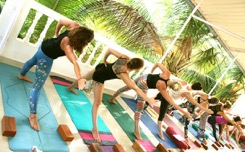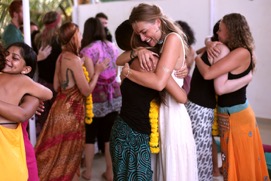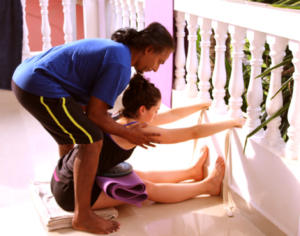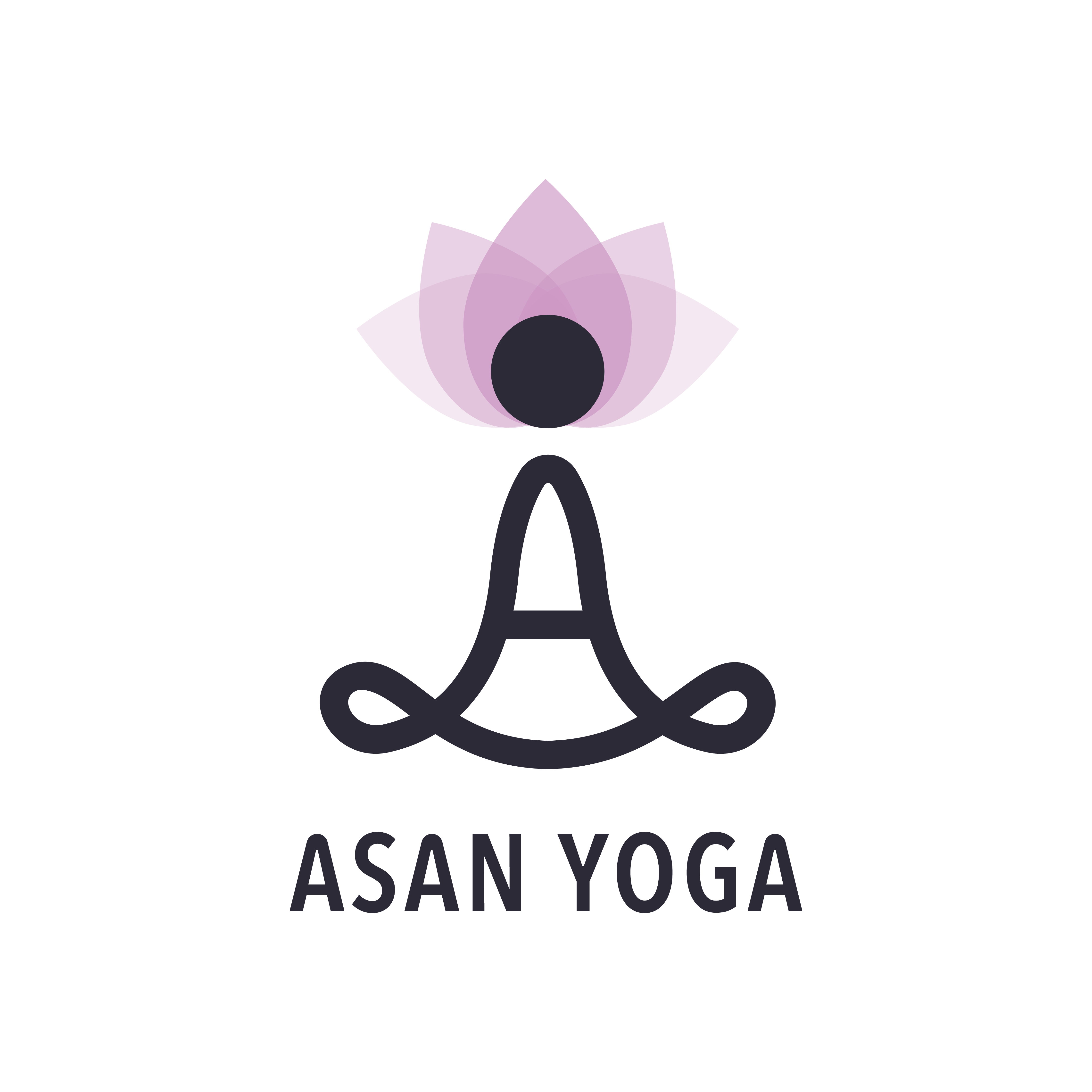- Ashtanga Vinyasa Yoga Practice: You can become a good teacher only when you have a dedicated practice and you are a committed and disciplined student. We’ll help you develop a regular practice. If you are a beginner in Ashtanga then you can ask for some extra guidance from your teachers. In case, you have a background in Ashtanga Vinyasa Primary Series practice then you will be supported to develop some asanas from the Second series. Our teachers will help you to find out the areas of difficulty and create a device to deal with it. It happens in our daily evening workshops which focuses on different areas of body and asana practice. We have different workshops such as hip-opener, shoulder-opener, arm strength builder, backward-extensions, forward-extensions and so on. Each of these workshops will take you further in your practice with greater understanding.
- Applied Anatomy, Physiology and Bio-Mechanics: This is the part of the training where a great Asana Teacher is born. In order to understand the dynamics of forces working on every posture you need to learn the Structure, Function and Applied Forces in your body which are working in a certain angle in every pose. Lack of this understanding causes injury not only for student but also for the teacher. When you are adjusting your student it is very important to understand the interplay of forces, your own balance and center of gravity.
Each poses of Ashtanga Series will be taught with Applied Anatomical Reflection, Key Alignment Points and Bio-Mechanic dynamics. These classes will immensely help you in developing your skills of adjustment and facilitating variations of yoga poses according to the structure and function of your students.
- Art of alignment and adjustment
Aligning your own body and your student’s body during performance of Asanas or even in activities of daily living is an art. Adjustment is less of a physical work and more of energetic work. Hence, when you are learning adjustment techniques your teacher will be observing and assisting you closely so that you can cultivate right kind of tender pressure by synchronizing your own body weight and breath with that of your student. This is the meaning of learning ‘hands on’ adjustment. Adjustment is a hand work and it comes only through long and conscious practice and learning the beauty of being present with your breath and every moment. You’ll be given assignment to prepare yourself for assisting in the class of a lead teacher and also you should feel free to volunteer for this opportunity during the course.
- Teaching Methodology
The Zen saying: “Now you got it, keep it well and share it.”

Teaching methodology is a gentle reminder for our students that you should learn the art of sharing your passion, vision and knowledge.
We’ll help you sharpen your observation of student’s posture and teach you the right technique to correct the faulty postures or rather assisting the student in finding their right posture. Teaching methodology classes continue during the first two weeks of training. Each and every pose of Ashtanga Primary Series chart will be discussed, pondered over and practiced under the guidance of your lead teacher.
- Art of sequencing a Vinyasa Flow Class:
 After completing your course when you go back home and start teaching in a studio, then you will meet all age group and fitness level people. You will need to adjust your classes according to your audience. Hence, we teach you the art of sequencing or creating a sequence of Vinyasa Flow Class. We’ll teach you some readymade sequence of Vinyasa flow in the beginning so that you will be able to create your own flow when you understand the underlying theory of Vinyasa Flow classes. You’ll learn that each vinyasa flow class has to have a theme behind it and it should revolve around that theme.
After completing your course when you go back home and start teaching in a studio, then you will meet all age group and fitness level people. You will need to adjust your classes according to your audience. Hence, we teach you the art of sequencing or creating a sequence of Vinyasa Flow Class. We’ll teach you some readymade sequence of Vinyasa flow in the beginning so that you will be able to create your own flow when you understand the underlying theory of Vinyasa Flow classes. You’ll learn that each vinyasa flow class has to have a theme behind it and it should revolve around that theme.
- Karma and Kriyas:
Karma is something you do without awareness and it creates a bondage or leaves a scar or pattern in your mind. Kriya is something done with your totality and awareness. We’ll teach you Yogic Kriyas to break the unconscious patterns of behavior and bring about a transformation in your life. These kriyas are known as cleansing processes and will be taught in details.
- Breathing, Mindfulness and Meditation:
These three terms differentiate yoga from mere physical exercise. Different techniques of breath awareness will be taught to you. You’ll be encouraged to develop a quality of mindfulness in daily activities. We’ll teach you easy meditation techniques which are dynamic and passive. So that you can make them part of your daily living, practice and assimilate them into your teaching.
- Yoga Sutra of Patanjali and Yoga Philosophy:
Patanjali is the founder of Yoga Philosophy and he is the first person who documented the practice of yoga in a very systematic, scientific and organized way in his book called Yoga Sutra of Patanjali.
Learning the Yoga Sutra of Patanjali is the core of becoming a Yoga Teacher. The first two Chapters will be taught to you in your 200-Hr YTTC. During 300-Hr YTTC those chapters will be revised and the 3rd and 4th chapters will be taught. Some other texts such as Bhagavadgita and Vingyanbhairav Tantra will also be introduced.
In context of Pranayama, Kriya and Asana Hathayoga Pradipika and Gherada Samhita texts will be quoted and explained.
- Practicum or getting into the role of being a teacher:
From the beginning of the course you will be encouraged to get into the role of a teacher by assisting in the classes and mentoring a student form 200-Hr training. This will help you to create a bonding with your students. You will start noticing their strength and struggles which will prepare you to design a device to help your students, this the beginning of a good teacher. This part of the training happens under the supervision of your lead teacher.
- Performance:
We observe your teaching skills and when we see that you are ready to take a full class then you will get an opportunity to stand facing your classmates and lead a class of Ashtanga Vinyasa yoga, but before that final presentation you will get many opportunity to teach in a small group with 3-4 people.
There will be written assessment in philosophy and anatomical reflection of yoga poses.
You will also receive some written assignments during the course which must be delivered by the end of the course.
- End of the Day:
 Different kinds of active and passive meditations are practiced at the end of the day. Evening meditations are important part of the course. Sometimes we practice Trataka, candle gazing, moon gazing, sunset watching, Kundalini meditation, some social meditation where you interact with other group members, whirling meditation and many more techniques of mediation.
Different kinds of active and passive meditations are practiced at the end of the day. Evening meditations are important part of the course. Sometimes we practice Trataka, candle gazing, moon gazing, sunset watching, Kundalini meditation, some social meditation where you interact with other group members, whirling meditation and many more techniques of mediation.
- Daily Schedule:
- 6:30 – 7.00 am Kriyas, Breathing, Inversions and Warm up
- 7.00 – 9.00 am Ashtanga Vinyasa Yoga Primary Series (Led Class or Mysore style self-practice)
- 9.00 am – 10.00 am Pranayama/ Chanting/ Meditation
- 10.00 am – 11.00 am Breakfast
- 11.00 am – 1.00 pm Yoga Anatomy/ Yoga Philosophy
- 1.00 pm – 2.00 pm Lunch
- 2.00 pm – 4.00 pm Rest and self-study
- 4.00 pm – 5.30 pm Teaching methodology
- 5.30 pm – 6.00 pm Tea break
- 6.00 pm – 8.00 pm Vinyasa Flow/ Art of sequencing/ Chanting/ Meditation
- 8.00 pm – 9.00 pm Dinner

*Our schedule is subjected to change according to weather and group condition.
500-Hr Yoga Teacher Training:
 If you wish to take 500-Hr training in one go then you should come for a longer stay at our Yoga School (a minimum of 8 weeks). First you may take 200-Hr Yoga Teacher Training then you can take a little break or can opt to go straight into 300-Hr YTTC which may qualify you for 500- RYT (Registered Yoga Teacher). However, you should remember that your certificate may not be registered at Yoga Alliance as RYT 500 until you have documented 100-Hr Yoga Teaching Experience starting from the date of completion for you first YTTC.
If you wish to take 500-Hr training in one go then you should come for a longer stay at our Yoga School (a minimum of 8 weeks). First you may take 200-Hr Yoga Teacher Training then you can take a little break or can opt to go straight into 300-Hr YTTC which may qualify you for 500- RYT (Registered Yoga Teacher). However, you should remember that your certificate may not be registered at Yoga Alliance as RYT 500 until you have documented 100-Hr Yoga Teaching Experience starting from the date of completion for you first YTTC.
Taking 500-Hr YTTC is considered the best way to go deeper into the practice and teaching of Yoga because of the emphasis on regular practice and the longer period of time spent in a yogic environment.

